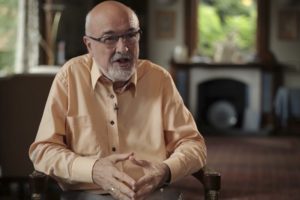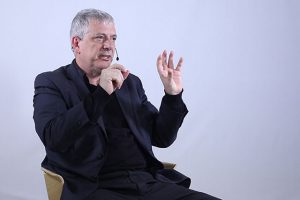Cognitive Variability
Neuroscientist Michael Thomas on differences between children, computational modeling, and the new skills that...
It’s quite difficult to tell where the word neurodegeneration came from. It’s now an accepted concept but I think as in all areas of science it’s very important to remember that this is a word that has been coined and we need to be very cautious before we think we’ve understood something just by naming it. What we mean by neurodegeneration is that the nervous system evolves and develops normally in an individual, and at some point in their life it begins to fail in a series of rather characteristic ways. There are some commonalities between these different neurodegenerative diseases, but actually, one very important principle is that they are all rather separate entities. That’s important from the point of view of trying to understand the biology and also how we might provide therapy for these disorders. A lot has been written in the past about the overlaps and some of the things that might mean that there might be one treatment for different forms of age-related degeneration but actually the more we learn the more we realize that these are complex diseases with their own particular biology.
So the chief neurodegenerative disease in terms of the way it affects society is Alzheimer’s disease, it’s clearly the most important. So Alzheimer’s disease overwhelmingly is the public health problem that we need to try and solve. Alzheimer’s disease was characterized in the late 19th century by pathologists, by people looking down microscopes and saying: well, here’s somebody in life who has a failing nervous system, what do we see in the brain? What characteristically was observed is a particular way in which proteins are accumulating in the brain: in Alzheimer’s, they are so-called amyloid plaques and tau tangles. In other diseases like Parkinson’s, there are particular forms of protein hallmark, in Parkinson’s it’s called the Lewy body and in ALS it’s called the ubiquitylated inclusion. So in common there is the observation that protein is accumulating in these cells but these are different proteins and actually, we don’t know whether it’s the accumulation of protein which is an injury phenomenon, or that’s a protective response, or it’s simply an epiphenomenon.
So neurodegenerative diseases have the clear common feature that they are age-dependent: we don’t see these disorders in infants or children except in very specific genetic disorders where the brain suddenly degenerates, but again, in rather different ways to the way in which it does in aging. So, an important question which often gets discussed is whether normal aging and neurodegeneration are in fact the same thing. That’s a very complex topic. Again, what do we mean by aging? We’re seeing the passage of time and things getting older. Is there a process called ‘aging’? So at the cellular level, there is a concept of cellular senescence where a number of things happen that prevent the cell after a particular period of years from regenerating and that’s effectively why aging occurs. The processes which are carrying neurodegeneration are somewhat different, however, they intersect because despite having a genetic makeup which might promote neurodegeneration either in the single gene level or in a complex way until you get aging, these other cofactors do not trigger the disease. So we have to understand both of these things and how they intersect. We are really at the beginning of our understanding of that.
So the classic degenerative disorders of Alzheimer’s and Parkinson’s and ALS account for most cases but then there is a whole range of other disorders which we classify under neurodegeneration. When people have sought to try and derive a taxonomy for neurodegeneration they have often put things together. For example, disorders that look a bit like Parkinson’s disease such as progressive supranuclear palsy, multiple system atrophy, corticobasal degeneration, Lewy body dementia, these disorders have some features of Parkinson’s, so they are called parkinsonian or parkinsonism disorders. Yet, while under the microscope there are some features which they have in common. There are clearly some differences. So, even though progressive supranuclear palsy gets misdiagnosed as Parkinson’s disease under the microscope is a tauopathy. The key protein which is deposited is tau protein, more like in Alzheimer’s disease. Corticobasal degeneration is the same whereas multiple system atrophy is what’s called a synucleinopathy because the protein in Lewy bodies in Parkinson’s is alpha-synuclein that is also present in multiple system atrophy.
So you begin to draw a family tree of these diseases based on the proteins accumulating but actually again one can be rather misled by that. Parkinson’s disease has numerous genetic contributions some of which are very well understood. With disorder like multiple system atrophy despite being a synucleinopathy there are not really any convincing examples of familial inheritance or genetics except in very rare situations. So we are still struggling to understand how we might organize these disorders into a system. If you just simply do it and you rely on neuropathology you get one answer, genetics – another answer, clinical features – another answer. So clearly what you really have to do is to become rather ultra reductionist and really understand the disorder at the more molecular level. There’re new technologies such as transcriptomics and proteomics are beginning to redefine diseases into subtypes based more on the biological profile and signals that are present in patient biofluids, for example.
However, with the great Public Health problem that is Alzheimer’s disease, one of the big challenges is that the number of actual cases of Alzheimer’s disease which are due to a single gene mutation is a very small indeed. In fact, ALS is much more of a genetic disorder than Alzheimer’s disease. But for all of these conditions, the way into therapy is through understanding the disorder, through modelling it in vitro and in vivo using the genetic forms of the disease. There are currently no real ways of doing it. Modelling sporadic disease is very challenging. Typically in the laboratories, we take a genetic mutation: let’s choose an example of C9orf72, that is a gene which can cause ALS, it can cause frontotemporal dementia both of which pathologically look rather similar under the microscope with ubiquitylated inclusions. Clinically they are slightly different. They can occur in the same family, so there’re some overlaps but they’re quite different phenotypes. So we might typically seek to model these diseases by using induced pluripotent stem cells to then establish in a culture of motor neurons or cortical neurons and try to understand the transcriptomic profile which is triggered by the mutation. But when you have a specific genetic mutation – and C9orf72 accounts for significant numbers of patients: 40% in our population of the familial cases of ALS and up to 10% of all ALS cases are due to mutations in C9orf72. So it’s a very important target. The kind of therapeutic approaches that you might apply here includes antisense oligonucleotides. The first clinical trials of antisense oligonucleotides are now in development. The way that C9orf72 causes disease is because of an expansion of an intronic region of repetitive DNA which then gets massively expanded from a handful of repeats of a hexon nucleotide into about a 1000-1500 repeats to cause disease. So antisense oligonucleotides can be used to antagonize the RNA which is the product of this and therefore in the laboratory you can demonstrate that you can correct the cellular phenotypes. Whether that is gonna be possible in the intact human nervous system once the disease has been triggered we are going to learn in the next few years.
But obviously one of the key therapeutic developments that we are very excited about is the concept of genome editing. In my laboratory and many others around the world, we’ve simply used CRISPR/Cas9 genome editing to remove the mutation in C9orf72 and correct everything in the cells and that at least establishes that concept, the principle that if you could apply that to patients you could actually correct the genetic mutation. The logical consequence of that is that what you’d really like to do is to correct it before the disease begins. For most degenerative diseases of the nervous system, there’s very good evidence that when the patient presents to a clinician they have already had the disease for a number of years and that they have used up most of their intrinsic reserves. For Alzheimer’s disease when it’s been studied the familial types there is already evidence of misfolded protein, the accumulation of beta-amyloid for 20 years or more before memory becomes disturbed. That tells you that there is an enormous amount of reserve.
So what we’d really like to do is to treat people 20 years before they’re likely to develop memory problems. To do that you need to be able to detect them, you need to be able to treat them safely so that you do not cause any harm, and need to work out how to do economically since these kinds of treatments are in therapy very expensive. So there are huge challenges even with the apparently rather simple genetic forms of neurodegenerative disease. If you consider that most forms are not clearly in a simple way genetic, they are sporadic where there are multiple different genetic susceptibilities, environmental triggers, intrinsic factors within the nervous system then we really have a huge challenge. I think to really conclusively treat neurodegeneration is a very complex task which is going to involve preventive strategies and it’s going to involve corrective strategies which really raises the question of whether regenerative medicine is possible in these disorders.
Around the world numerous institutes of regenerative neurology have been established. The concept is to try and reconstitute those nervous connections in order to restore function. That is a huge challenge. If you take the number of neurons there are in the brain which is likely to be twenty billion or so, each of those on average has reciprocal connections with maybe thousands of other cells. So the architecture of the brain which allows us to think, allows us to move and feel and do all our other functions is immensely complicated and arises during embryological development through an orderly expression of hundreds of genes which are patterned, signalling molecules, migration of cells and establishing of synaptic connections.
Of course, we have spent a hundred years or more looking down a microscope at these inclusions in degenerative diseases. The real physiology of these disorders or pathophysiology is of the synapse which is very far away from the cell body, difficult to visualize. It’s the synaptic function which gets lost in Alzheimer’s, Parkinson’s and ALS and that is what needs to be protected. So overall the challenge here is very huge but it’s a technical challenge and therefore ultimately will be overcome through improved knowledge but one can not underestimate it.

Neuroscientist Michael Thomas on differences between children, computational modeling, and the new skills that...

Neuropsychologist Chris Frith on mirror neurons, compassion, and how it depends on the sentiment towards the s...

Economist Sacha Bourgeois-Gironde on decision making in economics, 'Allais paradox' and perception of reward